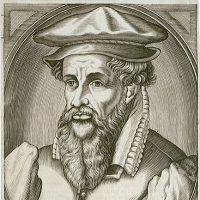

Mercartor was born Gerard de Kremer or de Cremer in the Belgian town of Rupelmonde to parents from Gangelt in the Duchy of Jülich, part of the Holy Roman Empire, where he was raised. “Mercator” is the Latinized form of his name. It means “merchant”. He was educated in ‘s-Hertogenbosch by the famous humanist Macropedius and at the University of Leuven. Despite Mercator’s fame as a cartographer, his main source of income came through his craftsmanship of mathematical instruments. In Leuven, he worked with Gemma Frisius and Gaspar Myrica from 1535 to 1536 to construct a terrestrial globe, although the role of Mercator in the project was not primarily as a cartographer, but rather as a highly skilled engraver of brass plates. Mercator’s own independent map-making began only when he produced a map of Palestine in 1537; this map was followed by another-a map of the world (1538) and a map of Flanders (1540). During this period he learned Italic script because it was the most suitable type of script for copper engraving of maps. He wrote the first instruction book of Italic script published in northern Europe.
Mercator went on to become the leading European globe maker of the age. Mercator’s terrestrial globe from 1541 is now in the museum collection of the Palazzo Ducale in Urbania, Italy, and is one of about 22 existing Mercator globes. In 1552, he moved to Duisburg, one of the major cities in the Duchy of Cleves, part of the United Duchies of Jülich-Cleves-Berg, Holy Roman Empire, and opened a cartographic workshop where he completed a six-panel map of Europe in 1554. He worked also as a surveyor for the city. His motives for moving to Duisburg are not clear. Mercator might have left the Netherlands for religious reasons or because he was informed about the plans to found a university. He taught mathematics at the academic college of Duisburg. After producing several maps, he was appointed Court Cosmographer to Wilhelm, Duke of Jülich-Cleves-Berg in 1564. He constructed a new chart and first used it in 1569. It had parallel lines of longitude to aid navigation by sea, and compass courses could be marked as straight lines.
Mercator took the word atlas to describe a collection of maps, and encouraged Abraham Ortelius to compile the first modern world atlas, Theatrum Orbis Terrarum, in 1570. He produced his own atlas in a number of parts, the first of which was published in 1578 and consisted of corrected versions of the maps of Ptolemy (though introducing a number of new errors). Maps of France, Germany and the Netherlands were added in 1585 and of the Balkans and Greece in 1588. Following his move to Duisburg, Mercator never left the city and died there in 1594, a respected and wealthy citizen. His son Rumold Mercator published additional maps in 1595 after his father’s death.
